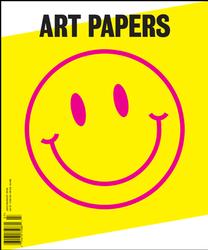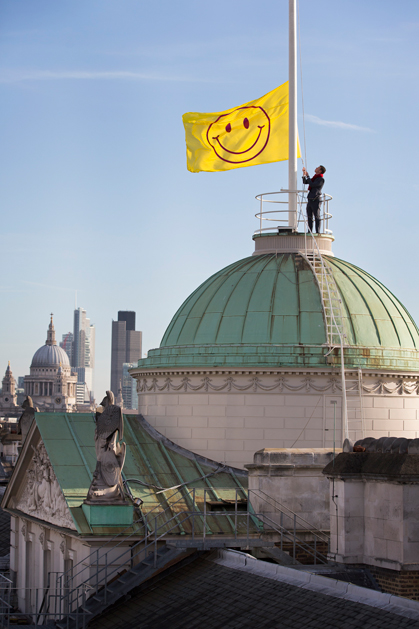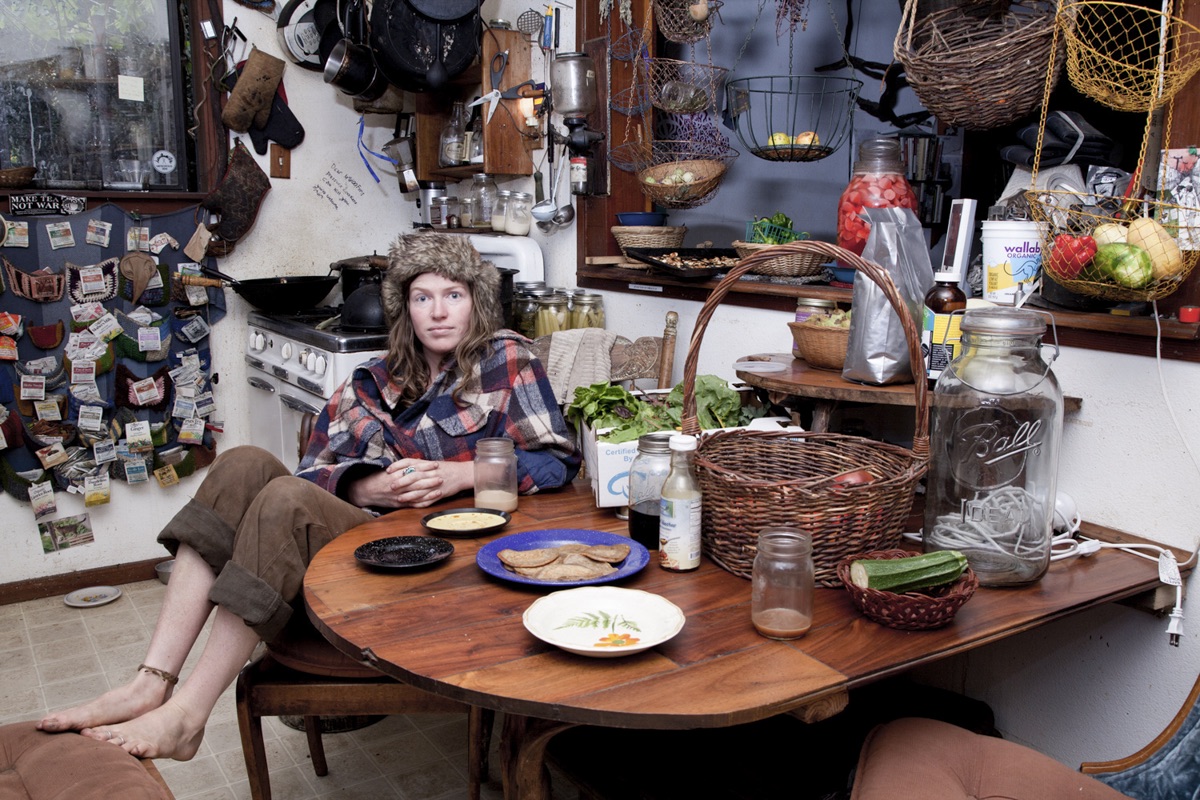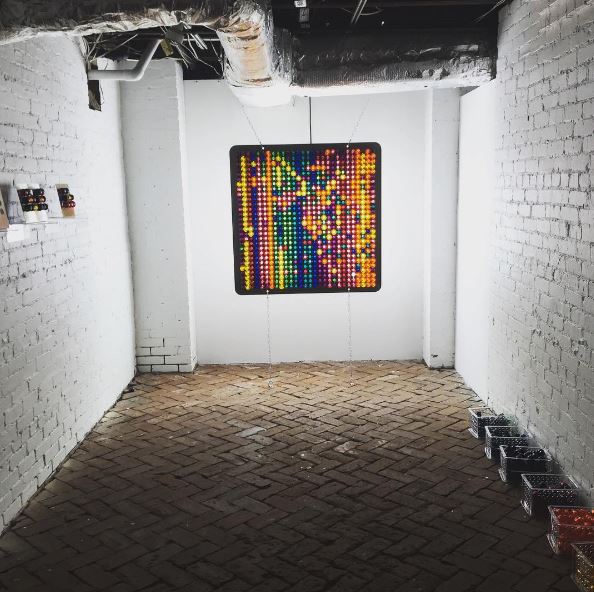.jpg) What is the best part of being editor-in-chief of ART PAPERS?
What is the best part of being editor-in-chief of ART PAPERS?
I love the freedom of editing an arts publication. Because ‘art’ and ‘culture’ can be very broadly defined, there is a sense of endless possibility in terms of what you can cover and who you can work with. Sure, it's a special interest magazine, yet because that special interest is art, you are automatically in a conceptual arena where every part of the visual world is a potential inspiration. We've worked with urban planners and policy makers; in September, we'll feature an interview with an Olympic campaign strategist. It makes for incredible conversation.
This month’s cover art is "Utopia Flag", 2016, by Jeremy Deller and Fraser Muggeridge, what qualities do you look for in your cover artist’s work?
For me, a cover image has to do more than connect to the headlining story in the magazine - it has to capture the essence of everything that's inside.
Cover art should be fun - in the magazine, we are often dealing with "high" concepts, and I think it's important to have a sense of humour when doing that. The July/August cover is essentially a smiley face; it also gets at some quite dark content. I liked the idea of that juxtaposition.
What are the challenges of being a magazine editor?
I think the challenges of the job overlap a great deal with its pleasures. You are working with dozens of individuals for each issue, yet you are trying to make something cohesive, authentic, inspiring - sometimes this involves some problem-solving and diplomacy; you have to put the artist's vision above your own. If something is not done right, it's the editor's responsibility, whether it's how you punctuate or how you address the big picture.
As an editor you're working all the time. If I am at the movies, I'm thinking about how the cinematography is reminding me of a certain painter and wondering if we can do something with that. I'll see an advertisement and think, so many people are using that imagery or that language right now... should we put it in the magazine? Should we find out where it is coming from and talk to the person who started it all? It's a fabulous position to be in - for it to be your job to observe the world and reflect upon what you see - but you can't ever ‘go home’ from an editorship.
ART PAPERS is a non-profit organization concentrated on how contemporary art and culture effect society today, could you explain more about this?
ART PAPERS began as the newsletter for the Atlanta Art Workers Coalition, which was essentially a group of artists who would meet to share concerns and support their community. The first issue came out in 1977 and it was just one page, printed with information about studio space and grant resources. But the publication ‘stuck’ and grew; we're still based in Atlanta, but we're distributed all over the world.
That history makes us unique among art publications because we're coming from a social context, having been founded as a platform to support artistic dialogue. We also program public and educational programming, which provides an opportunity to continue the conversations we put out there in print, in real time.
ART PAPERS began in Atlanta, and you’re still based there. How has/does Atlanta communicate and respond to more ‘central’ movements in the Western art world?
Traditionally, Atlanta has been marginalized in conversations about art, which tend to focus on New York. Yet my sense is that the art world is decentralizing now, and people are hungry for viewpoints coming from other spheres. I'm one of those people, which is part of what attracted me to ART PAPERS: I wanted to learn something, and Atlanta has taught me a lot - about America, about the politics of art and of history. Atlanta is a young city, but it's very big in terms of scale and wealth. Like a teenager after a growth spurt, it's still wobbly and considering its own identity - which is a great place to be if you're an art magazine whose raison d'être is to question things.
Who are some of ART PAPERS’ favourite artists at the moment?
I couldn't possibly pick favourites! But in the current issue we have a feature on Mike Rakowitz, an amazing Chicago-based artist known for his socially-engaged work, often addressing America's relationship to the Middle East. We also have an original photo commission by Ruth Dusseault, an Atlanta-based artist whose work often documents alternative communities and subcultures. I love having the ability to put local and international artists in the same space - it always turns out artists are having similar conversations and asking similar questions, everywhere.
What is your favourite way to relax once an issue is completed?
I usually find myself getting on a plane afterwards. But I love airports and airplanes - they're the only places where you can observe all this human endeavour and adventure around you, while quietly enjoying some ‘me time’.
What can subscribers expect from future issues? Why subscribe?
We're not just for art connoisseurs and professionals - ART PAPERS covers all types of topics, because that's what artists are talking about. In January 2017, we'll release a special architecture and design issue that will look specifically at the city of Los Angeles. In the spring, we'll have an issue dedicated to the legacy and cultural influence of Philip K. Dick - it turns out a lot of incredible writers and artists are "Dick-heads," as the fans say, so we will have some truly amazing and original contributions.
We're launching a totally new website in a few months, and there will be special features and digital exclusives for subscribers there, as well as fun new merchandise. We're growing all the time, and subscribers will get a front row seat at that, all while supporting the arts! It's not just subscribing to a magazine - it's really a kind of community membership.
Can you tell your Hockneys from your Hirsts? To brush up on your own modern art connoisseurship, subscribe to ART PAPERS.
Images: Top top Bottom: Victoria Camblin by Jill Frank, ART PAPERS cover image, Didi Dunphy at Whitespec Gallery, Jeremy Deller and Fraser Muggeridge, Ruth Dusseault, Aubrey in Kitchen, Green Valley Village, 2013,
isubscribe REWARDS
Instant £5 credit > Read more

